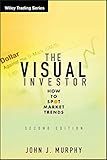Best Beginner Guides on ADX to Buy in January 2026
The Average Directional Index (ADX) is a popular technical indicator used by traders to assess the strength of a trend and potential trading opportunities. While its main purpose is to measure the strength of a trend, it can also be useful in determining whether a market is trending or ranging.
To begin trading with the Average Directional Index as a beginner, there are a few key points to keep in mind. First, it's important to understand the components of the ADX. The ADX consists of three lines: the ADX line itself, along with the +DI (Positive Directional Indicator) and -DI (Negative Directional Indicator) lines. The ADX line measures the strength of the trend, while the +DI and -DI lines indicate the direction of the trend.
When using the ADX, traders typically look for two important conditions: the ADX line's level and its slope. The level of the ADX line can help identify whether a trend is strong or weak. A reading above 25 is generally considered to indicate a strong trend, while a reading below 20 suggests a weak trend or a ranging market.
Furthermore, the slope of the ADX line can provide insight into the trend's momentum. If the ADX line is sloping upwards, it indicates a strengthening trend, while a downward slope suggests a weakening trend. Thus, traders often look for opportunities where the ADX line is both above 25 (indicating a strong trend) and sloping upwards (indicating increasing momentum).
To determine trading opportunities with the ADX, traders may also use the +DI and -DI lines. If the +DI crosses above the -DI, it is seen as a bullish signal, suggesting that buyers have taken control, and a trader might consider going long or buying. Conversely, if the -DI crosses above the +DI, it signals a bearish trend, indicating that sellers are dominating, and a trader may consider going short or selling.
It's important to note that the ADX is not a standalone indicator, and it is often used in combination with other technical indicators or analysis techniques to confirm trading signals. Additionally, like any indicator, the ADX is not foolproof and can provide false signals. Thus, it is recommended to practice using the ADX in a demo account or with small trades before applying it to real-money trading.
Overall, the ADX is a useful tool for beginner traders to assess the strength of a trend and identify potential trading opportunities. By understanding the components of the ADX, monitoring its level and slope, and considering the +DI and -DI lines, traders can incorporate this indicator into their trading strategies effectively.
What is the relationship between the ADX and trend reversal patterns?
The Average Directional Index (ADX) is an indicator used to determine the strength of a trend. It does not specifically indicate trend reversal patterns, but it can provide valuable information to traders to identify potential reversals.
When the ADX is low, such as below 20, it suggests a weak or non-existent trend. This might indicate that a current trend is losing strength and a reversal may be imminent. In such cases, traders can look for reversal patterns like double tops or bottoms, head and shoulders, or trendline breaks.
On the other hand, if the ADX is high, typically above 30 or 40, it indicates a strong trend. In this scenario, traders might not be actively looking for reversals. However, when the ADX starts to decline from high levels, it can signal a potential weakening of the trend and a possible reversal. Traders can then monitor for reversal patterns to validate the reversal signal.
It is important to note that while the ADX can provide insight into the strength of a trend, it does not guarantee trend reversals. Traders should also use other technical analysis tools and indicators in conjunction with the ADX to confirm trend reversal patterns before making trading decisions.
How to use the ADX to assess the strength of a particular stock?
To use the Average Directional Index (ADX) to assess the strength of a particular stock, follow these steps:
- Obtain historical price data: Gather the historical price data for the stock you want to assess. The more data you have, the better your analysis will be.
- Calculate the Directional Movement Index (DMI): The ADX is derived from the DMI, which consists of three lines - positive direction indicator (+DI), negative direction indicator (-DI), and the ADX line itself. Calculate the +DI and -DI lines using high and low price values.
- Calculate the True Range (TR): The True Range measures the volatility of the stock and is calculated by finding the greatest of the following: the difference between the high and low price, the difference between the high price and the previous close, and the difference between the low price and the previous close. Calculate the Average True Range (ATR) by averaging the TR values over a particular period (e.g., 14 periods).
- Calculate the Directional Index (DX): The Directional Index (DX) is derived from the +DI and -DI indicators and helps determine the strength of the trend. Find the absolute difference between +DI and -DI and divide it by the sum of +DI and -DI. Multiply the result by 100 to get the DX.
- Calculate the ADX: The ADX is calculated by smoothing the DX values over a particular period using a moving average. The most common period used is 14. Plot the ADX line on a chart.
- Interpret the ADX values: A high ADX value suggests a strong trend, while a low ADX value indicates a weak or indecisive trend. Typically, an ADX value above 25 is considered to indicate a strong trend. Additionally, a rising ADX implies increasing trend strength, while a declining ADX suggests a weakening trend.
- Analyze in conjunction with other indicators: It's important to use the ADX in combination with other technical indicators or chart patterns to get a comprehensive view. For example, you can look for a rising ADX along with higher highs and higher lows on the price chart to confirm a strong uptrend.
Remember, the ADX is just one tool among many for assessing stock strength, and it should be used in conjunction with other technical and fundamental analysis techniques to make informed investment decisions.
What is the significance of the ADX crossing above or below certain levels?
The Average Directional Index (ADX) crossing above or below certain levels signifies the strength and direction of a trend in a market. The ADX is a widely used technical analysis indicator to determine the strength and momentum of a trend. When the ADX crosses above certain levels, it is considered a signal that a trend is strengthening, indicating an increase in the momentum of buying or selling pressure. Traders and investors may interpret this as an opportunity to enter or hold onto a position in the direction of the trend, expecting further price movement.
Conversely, when the ADX crosses below certain levels, it suggests a weakening or sideways movement in the trend. This may indicate a decrease in the strength or momentum of buying or selling pressure, possibly signaling a potential trend reversal or a period of consolidation. Traders and investors may view this as a cautionary signal to either exit or avoid entering new positions until a clearer trend emerges.
The specific levels at which the ADX is considered significant may vary depending on an individual's trading strategy, market conditions, or other technical indicators used. Some common thresholds are 20, 25, or 30, where a cross above these levels indicates a stronger trend, while a cross below suggests a weaker trend. It is important to note that traders often combine the analysis of ADX with other technical tools to make more informed trading decisions.
How to use the ADX to identify divergence signals?
To use the Average Directional Index (ADX) to identify divergence signals, follow these steps:
- Understand the concept of divergence: Divergence occurs when the price of an asset moves in the opposite direction of a technical indicator. It indicates a potential trend reversal or weakening of the prevailing trend.
- Plot the ADX indicator: ADX is typically displayed as a line on a chart, ranging from 0 to 100. A higher ADX value indicates a stronger trend, while a lower value suggests a weaker trend or a sideways market.
- Identify the trend: Before looking for divergence signals, determine the prevailing trend in the price chart. ADX can help you identify the strength of the trend.
- Look for divergence with price: Once you've identified the trend, compare the price action with the ADX line. Look for instances where the price is making higher highs (in an uptrend) or lower lows (in a downtrend), while the ADX line is making lower highs or higher lows, respectively. This indicates a potential divergence signal.
- Confirm with other indicators: Divergence signals should be confirmed with other technical indicators. For example, you can check for divergence with oscillators like the Relative Strength Index (RSI) or the Moving Average Convergence Divergence (MACD). If these indicators also exhibit divergence, it strengthens the probability of a trend reversal.
Remember, divergence signals are not foolproof and should be used in conjunction with other technical analysis tools. It is always recommended to practice proper risk management and use other confirmatory signals before making any trading decisions.
What is the historical performance of the ADX indicator?
The Average Directional Index (ADX) indicator was developed by J. Welles Wilder in the 1970s. It is primarily used to determine the strength of a trend in the financial markets. ADX measures the intensity of directional movement, whether it is an uptrend or a downtrend.
The historical performance of the ADX indicator has been widely regarded as a useful tool for identifying and confirming trends. Traders and investors use the ADX to filter out noise and identify strong trends worth trading or investing in.
However, it is important to note that the ADX indicator should not be used as a standalone tool for making trading decisions. It is best utilized in conjunction with other technical analysis tools and indicators to build a comprehensive trading strategy.
While historical data and backtesting may show positive results for using the ADX indicator, it is essential to adapt its usage to suit individual trading styles and preferences. Additionally, market conditions can change, and no indicator can guarantee future performance.




